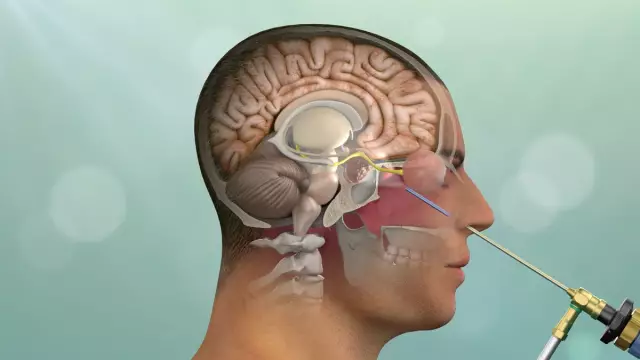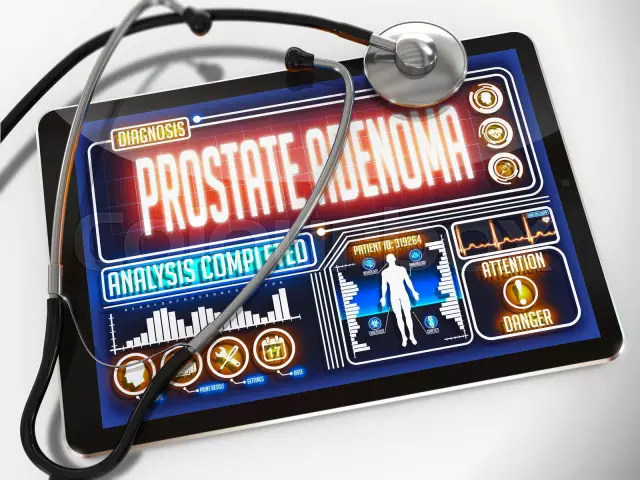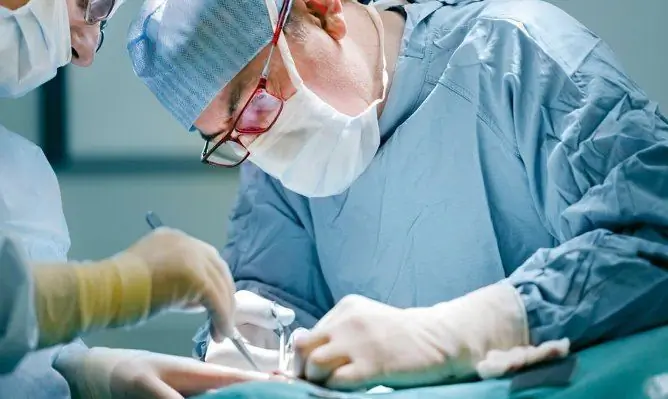- Author Rachel Wainwright [email protected].
- Public 2023-12-15 07:39.
- Last modified 2025-11-02 20:14.
Effective drugs and medicines for the treatment of prostatic hyperplasia (prostate adenoma) without surgery
The content of the article:
- About the disease
- The reasons
- The mechanisms of development of the pathological process
- Symptoms
- Diagnostics
- Stages
- Complications
-
Treatment
- Alpha blockers
-
Other types of drugs
- 5-alpha reductase inhibitors
- Muscarinic receptor antagonists
- Beta-3-adrenergic receptor agonists
- Type 5 phosphodiesterase inhibitors
- Vasopressin analogs
- Candles Adenosin
- Conclusion
Adenoma of the prostate gland is one of the most common diseases of men, and with the increase in life expectancy, an increasing number of men suffer from this disease, and the older the age, the higher the likelihood of developing this disease. So, symptoms associated with prostatic hyperplasia in men aged 40-50 years are observed in 25-35% of cases, and over the age of 70 years - in 75-80% of cases. It is important that benign prostatic hyperplasia (BPH) significantly reduces the quality of life. Sexual (decreased potency and erection) and dysuric (poor-quality urination) disorders develop. A man ceases to feel himself a man, a fear of intimacy appears. However, modern medicine does not stand still. New and effective drugs for the treatment of this disease are being developed every year. Therefore, do not despair if you are faced with an adenoma. The main thing is to visit a doctor on time and start the correct treatment.

About the disease
Adenoma of the prostate, or as it is now accepted to say in the medical environment, benign prostatic hyperplasia (BPH) is a multifactorial disease characterized by the growth of predominantly glandular tissue located around the prostatic urethra. Changes can be diffuse or nodular. As a result of BPH, symptoms of lower urinary tract compression and urinary disturbances appear.
The reasons
The reasons leading to the development of the hyperplastic process have not been finally established. However, risk factors have been identified that increase the likelihood of pathology:
- Age. The incidence of pathology increases with age. Almost every man over 70 has signs of prostatic hyperplasia, and therefore requires treatment.
- Hormonal background. In men who underwent removal of the testicles before puberty, adenoma does not develop.
- Inflammation of the prostate gland. More than half of cases of BPH are associated with an inflammatory process in it, so scientists have concluded that inflammation can provoke hyperplasia.
A causal relationship with genetics has not yet been established. It is assumed that it does exist. Therefore, if the closest male relatives had this disease, it would not be superfluous to visit a urologist regularly (once a year) after 40 years.
By the way, epidemiological studies have shown that the Japanese have the lowest risk of developing prostate adenoma. Medicine cannot explain this yet.
The mechanisms of development of the pathological process
A few words about what happens in the prostate. The growth of the first hyperplastic foci begins with the formation of nodules around the urethra, which passes through the prostate gland. It is this zone that is especially sensitive to estrogens - female sex hormones, which are normally formed in small quantities in the male body. It has been suggested that it is estrogens that affect androgens and the latter trigger the process of cell division, leading to hyperplasia. That is, male steroids are the primary culprit, and female steroids are the secondary (activator of this process).
Symptoms
BPH is a chronic condition that progresses slowly but steadily. The course is accompanied by periods of improvement and aggravation of clinical symptoms.
Conditionally, the manifestations of hyperplasia are divided into 2 groups:
- Obstructive manifestations, i.e. due to compression of the urethra.
- Irritative manifestations, i.e. associated with irritation of the urinary tract receptors.
Symptoms in the first group include:
- the appearance of a "sluggish" stream of urine, as well as the release of urine drop by drop;
- intermittent urination;
- Difficulty emptying the bladder, the need to strain a lot;
- feeling of incomplete emptying of the bladder.
Symptoms of the second group include:
- false urge to urinate;
- frequent urination day and night (more than 2 times per night) in small portions;
- the inability to delay the act of urination when the urge occurs;
- pain when emptying the bladder.
It should be noted that the symptoms of prostatic hyperplasia are nonspecific, therefore, based only on clinical manifestations, it is not possible to establish a diagnosis. If this disease is suspected, additional methods of examination are shown. Only after a well-established diagnosis is BPH treatment prescribed.
Diagnostics
The diagnostic search begins with filling out special questionnaires to assess the severity of symptoms, and then objectively examining the prostate through the rectum: the size, consistency, soreness of the gland, as well as changes in the seminal vesicles are determined.
The next stage is laboratory:
- PSA analysis. All men over 50 years of age are shown to determine the concentration of prostate-specific antigen (PSA) in the blood. This marker allows early detection of prostate cancer. With a burdened family history, PSA is assessed in patients at an earlier age (45+).
- General clinical urine analysis. The test can rule out / confirm urinary tract infections and detect the presence of blood and urine glucose, which may indicate other conditions that may require different treatment.
- Determination of the level of creatinine in the blood. Creatinine is an end product of protein metabolism, which is excreted mainly by the kidneys. This indicator is used to judge their functional state, which makes it possible to exclude renal failure (with this complication, the level of creatinine in the blood rises).
After laboratory examination, the urologist proceeds to the instrumental stage of diagnosis:
- An ultrasound scan of the prostate and bladder through the anterior abdominal wall and then through the rectum. The transabdominal method allows detecting malignant neoplasms and assessing the condition of the tissues. With the help of a transrectal examination, it is possible to study in detail the state of the entire prostate gland and directly the areas of hyperplasia. Ultrasound imaging is essential when planning an operation, as well as assessing the potential for drug therapy.
- Ultrasonic determination of the volume of urine remaining in the bladder after its "complete" emptying. First, with a transabdominal ultrasound, the volume of a full bladder is assessed, then the patient goes to the toilet and empties it. On return, the volume of residual urine is assessed. Sometimes this indicator can be determined using catheterization.
- Ultrasound examination of the kidneys. Allows you to determine the state of their parenchyma, expansion of the calyx and pelvis, as well as exclude / confirm the presence of stones. The study is recommended for all primary patients.
- Uroflowmetry. This diagnostic procedure evaluates the characteristics of the act of urination. A graphical recording of the time-varying urination rate is made. The study is performed at least 2 times to exclude possible errors. The conditions for the reliability of the results are - filling the bladder in a volume of 150-350 ml and the appearance of a natural urge to empty it.
- Comprehensive urodynamic study (KUDI). Allows you to study the mechanisms of urinary tract obstruction in the background of adenoma, as well as to make a conscious selection of patients for surgery. Based on the results of KUDI, the doctor can determine which factor is fundamental in the violation of urination - compression of the urethra by an enlarged gland, or spasm of the lower parts of the urinary tract, or a decrease / increase in the contractile activity of the detrusor, or a violation of the innervation of the bladder.
The patient examination program is compiled individually and depends on age, family history, accompanying symptoms and other factors. The diagnostic search can be expanded using other methods - retrogenographic, tomographic, etc.
Stages
In modern urology, a staged classification of prostatic hyperplasia is adopted:
- Compensated stage - there are urination disorders that appear when the bladder is full.
- Subcompensated stage - the functional state of the bladder is disrupted, while residual urine appears in it.
- Decompensated stage - the bladder practically ceases to function normally, therefore, even with its overflow, there is no urge to urinate (paradoxical urinary retention), complications from the urinary system develop.
Complications
With a benign proliferation of prostate tissue, the prostatic part of the urethra is compressed, as well as its deformation and curvature. This is accompanied by a violation of the act of urination.
At the beginning, the bladder intensifies the contraction of the detrusor so that the urine stream can overcome the obstacle that has appeared and still be released. However, later, the functional reserves of the organ are not enough, its muscular membrane (detrusor - the muscle that contracts the bladder) grows. This is how trabeculae are formed, between which urine is retained. This is the stage when residual urine appears. It only gets worse over time if no treatment is given. A man begins to suffer from chronic urinary retention until the complete cessation of urine flow. At this stage, irreversible changes develop in the bladder wall.
In case of prostatic hyperplasia, the upper urinary tract is also involved. As a result of increased urinary pressure, renal tissue suffers, which over time leads to chronic kidney failure. A conditionally pathogenic microflora may also activate with the development of pyelonephritis, when bacteria enter the kidney ascending from the bladder.
Against the background of prostatic hyperplasia, 70% of men develop chronic prostatitis. This is due to stagnation of venous blood and ischemic tissue changes. In such conditions, pathogenic microorganisms quickly become active and provoke infectious inflammation, which further disrupts the act of urination. In such a situation, antimicrobial treatment is additionally required.
Strongly dilated veins, inside which blood pressure is increased, can begin to pass red blood cells through the vascular wall. So in the urine with prostate hyperplasia, blood appears, visible visually. With adenoma, secondary formation of calculi in the bladder is also possible due to prolonged stagnation of urine.
Acute urinary retention is a complication that requires urgent treatment. It can occur at any stage of the disease. As a rule, this complication is provoked by certain factors - the use of alcoholic beverages, too salty, peppery and spicy foods, hypothermia, prolonged absence of stool, untimely emptying of the bladder, stressful situations, taking certain medications (antidepressants, diuretics, calcium channel blockers, etc.) and acute circulatory disorders in the prostate.
The list of complications in prostatic hyperplasia is quite extensive, and many of them pose a serious danger to the patient. Therefore, it is so important to start timely treatment.
Treatment
Lifestyle modifications must be made before starting drug treatment. Patients with prostatic hyperplasia are advised to:
- come for follow-up examinations to the urologist at intervals of once every 6-12 months;
- reduce the amount of fluid you drink at "inappropriate hours" - before an important meeting, a festive event, a night's sleep (this will reduce the frequency of urination);
- limit the consumption of caffeine and alcoholic beverages; these substances irritate the urinary tract and increase diuresis;
- relax while urinating;
- optimize your diet by increasing the amount of fiber to prevent constipation.
Only by adhering to these rules, you can achieve the desired effect from drug treatment.
Alpha blockers
Alpha blockers are one of the most commonly prescribed groups of drugs for treating the symptoms of prostatic hyperplasia. They block the postsynaptic action of norepinephrine on the corresponding receptors. As a result, the tone of the smooth muscles of the prostate and urethra decreases and, as a result, the symptoms are eliminated.
Alpha-blockers are symptomatic, usually in patients with mild enlargement of the prostate. Treatment continues for a long time, often all life after diagnosis, because the disease is characterized by a progressive course. The effectiveness of this group of drugs may decrease over time.
Currently, there are 5 registered medicines representing this group - Tamsulosin, Alfuzosin, Silodosin, Terazosin and Doxazosin. The difference between them is in the level of tolerance, the effectiveness in the recommended doses is the same for everyone. The most common side effect is a drop in blood pressure. A urologist will help you choose the right drug. Some require a titration mode, i.e. start with minimal dosages, and then, depending on the clinical effect, an increase occurs. Self-treatment is dangerous!
Other types of drugs
5-alpha reductase inhibitors
They have an antiandrogenic effect, because block the transition of inactive testosterone to the active form - dihydrotestosterone.
The initial assessment of the result is carried out only after 6-12 months. Studies have shown that these drugs are unique - they can reduce the volume of hyperplasia by almost three times and prevent their further growth.
However, this group has one serious side effect - deterioration of sexual function, especially pronounced in the first year of taking the drug.
Muscarinic receptor antagonists
These drugs are preferred for moderate and severe urination disorders. They block the parasympathetic nerves and thus reduce the overactive bladder. As a result, the frequency of daytime and nighttime urination decreases, as well as the irresistible urge to empty the here and now, which is called urgency in medicine.
Muscarinic receptor antagonists should not be used in the presence of a large volume of residual urine, because they can cause acute urinary retention.
Beta-3-adrenergic receptor agonists
This class of receptors is mainly found in the muscle that contracts the bladder. Excitation of these receptors leads to relaxation of smooth muscle cells. The drug allows you to cope with frequent urination and urgency.
This class of medications often increases blood pressure. Therefore, the use is contraindicated in the presence of severe arterial hypertension, which does not have an adequate level of control. Some patients may develop dry mouth and constipation.
Type 5 phosphodiesterase inhibitors
The drugs increase the concentration of cyclic guanosine monophosphate inside the cell, which leads to relaxation of smooth muscle cells. Clinically, this is manifested by an improvement in the act of urination and the normalization of the bladder.
It is important that these drugs are also used in the treatment of impaired erection, i.e. do not cause sexual dysfunction. These medications have been shown to improve blood circulation in the pelvic organs.
Vasopressin analogs
The main indication for their use is frequent nighttime urination, which does not allow a person to get enough sleep. The drugs enhance the process of reabsorption in the renal tubules and thereby reduce the volume of urine excreted.
Affect the concentration of sodium in the blood. Therefore, it is recommended to determine the level of this element in plasma with a frequency of once every 3-6 months and, if necessary, carry out appropriate correction.
In cases of late diagnosis, drug treatment may no longer bring the desired result. Then the question of the operation is decided. The main indications are:
- frequent urinary retention;
- a pronounced degree of compression of the lower urinary tract;
- urolithiasis disease;
- repeatedly appearing blood in the urine;
- chronic urinary retention with a large residual volume of urine in the bladder;
- lack of result from the use of medicines.
The essence of the operation is to eliminate mechanical compression of the prostatic part of the urethral canal. A classic (scalpel) adenomectomy can be performed, as well as transurethral resection of prostatic hyperplasia. Currently, minimally invasive techniques are being widely introduced. However, any operation is stressful for the body and a certain medical risk. Therefore, it is better to promptly start taking effective drugs that reduce the degree of hyperplasia and improve the functional state of the prostate gland.
Candles Adenosin
The drug Adenosin is a natural complex drug that suppresses the activity of the inflammatory process and fights free radicals that have a damaging effect on the gland tissue. As a result of the application, the formation of leukotrienes and prostaglandins decreases, which leads to a decrease in inflammatory edema and an improvement in microcirculation.
Patients notice a positive result from the first days of starting therapy. The act of urination is accelerated, the bladder is almost completely emptied, the frequency of night urination decreases. The medicine is recommended for use with prostate adenoma, as well as chronic prostatitis. The duration of treatment is 1 to 3 months. Suppositories are injected into the rectum once a day after the act of defecation, preferably after the introduction to be in a horizontal position for 30-40 minutes.
Conclusion
Benign prostatic hyperplasia still has no effective preventive measures. However, early detection and initiation of treatment can significantly slow down this process and avoid the development of serious complications. Modern drugs give a man a decent quality of life, incl. sexual. Be healthy!
Found a mistake in the text? Select it and press Ctrl + Enter.






